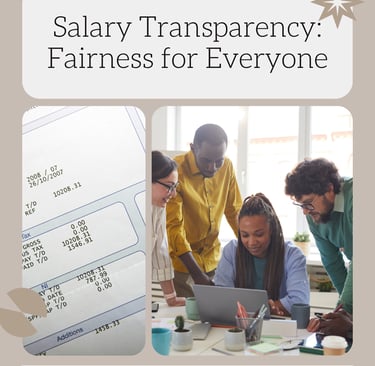Salary Transparency: Scary for You, Fair for Them
Why more companies are choosing openness—and why it matters now more than ever. For decades, salaries have been a workplace secret. But as employees demand fairness, and companies fight to build trust and retain top talent, transparency is no longer a nice-to-have — it’s a strategic move. In this article, we explore the benefits, the fears, and the facts behind salary transparency — and how smart businesses are making the shift.
6/2/20252 min read


💰 Salary Transparency: Scary for You, Fair for Them
Why more companies are opening the books — and why it might be the smartest move you make.
👀 “We don’t talk about money here.”
That’s what Michelle, a mid-level employee at a Caribbean-based firm, was told when she asked about salary bands during a team expansion. Months later, she discovered a junior colleague with less experience was earning significantly more. Her trust was shaken, her morale plummeted, and eventually — she left.
This is not rare. It’s the reality for thousands of employees in organizations that still treat pay as a secret. And while salary transparency may feel intimidating to employers, the cost of silence is often greater than the risk of clarity.
🧠 What Is Salary Transparency?
It means openly sharing:
Salary ranges on job ads 📝
Internal pay scales by level or role
Criteria for raises, bonuses, and promotions
How compensation decisions are made and reviewed
It doesn't mean everyone earns the same — it means everyone understands how and why pay decisions happen.
📊 Why Employers Are Still Hesitant
For many companies, the fear sounds like this:
“What if someone gets upset?” 😟
“What if we expose pay gaps we can’t fix yet?”
“What if this causes friction among team members?”
But here’s the truth: People already talk. What they don’t have is clarity.
✅ What the Research Says
30% of employees are more engaged at companies with pay transparency
Reduced turnover is reported where employees understand pay structures
Pay gaps between men and women shrink by up to 40% with transparency policies
Job seekers are significantly more likely to apply when salary ranges are listed
✨ The Benefits of Salary Transparency
For Employers:
🔓 Builds trust and credibility
🚀 Increases engagement and retention
🛠️ Simplifies recruitment and negotiations
🧩 Helps identify and correct internal disparities
💬 Encourages honest, performance-based conversations
For Employees:
💡 Increases clarity and fairness
🙌 Improves job satisfaction and loyalty
🔄 Encourages skill development aligned with growth
🔎 Empowers more confident career decisions
💼 The Future Is Open
Around the world — and increasingly in the Caribbean — organizations are waking up to the fact that salary secrecy breeds resentment, not loyalty. Whether it’s required by law or not, transparency is becoming a competitive advantage.
If you're serious about building a healthy workplace culture, retaining top talent, and closing equity gaps — it starts with being clear about compensation.
📚 References:
Harvard Law Review – Effective Pay Transparency Requires Benefit Transparency
https://harvardlawreview.org/blog/2024/11/effective-pay-transparency-requires-benefit-transparency-h-4890PayScale – Pay Transparency and Its Impact on Employee Satisfaction
https://psico-smart.com/en/blogs/blog-what-role-does-pay-transparency-play-in-employee-satisfaction-and-retention-145886WorkTango – Advantages and Disadvantages of Pay Transparency
https://www.worktango.com/resources/articles/advantages-and-disadvantages-of-pay-transparencyMy Journal Courier – New Illinois Laws on Pay Transparency (2025)
https://www.myjournalcourier.com/news/article/nearly-300-new-illinois-laws-take-effect-2025-19998179.php
